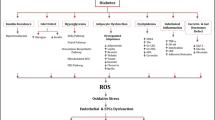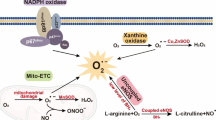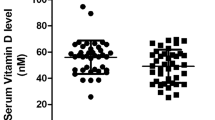Abstract
Dyslipidemia and hyperglycemia portray “cause-and-consequence” of type 2 diabetes mellitus (T2DM). They are linked to malondialdehyde (MDA) and methylglyoxal (MGO) generation that result from membrane lipid peroxidation and oxidative glucose conversions. We compared the effects of exogenous MDA and MGO on human umbilical vein endothelial cells and found that MDA but not MGO impairs insulin activation of PI3-kinase pathway, NO production, and endothelial barrier capacity. MDA abolished insulin activation of Akt and eNOS but not that of IRS. These results substantiate the hypothesis that MDA may be involved in endothelial dysfunction as an early event in the development of T2DM.



Similar content being viewed by others
REFERENCES
Boden G., Chen X., Ruiz J., White J.V., Rossetti L. 1994. Mechanisms of fatty acid-induced inhibition of glucose uptake. J. Clin. Invest. 93, 2438–2446.
Petersen M.C., Shulman G.I. 2018. Mechanisms of insulin action and insulin resistance. Physiol. Rev. 98, 2133–2223.
Sena C.M., Pereira A.M., Seica R. 2013. Endothelial dysfunction—a major mediator of diabetic vascular disease. Biochim. Biophys. Acta. 1832, 2216–2231.
Shi Y., Vanhoutte P.M. 2017. Macro- and microvascular endothelial dysfunction in diabetes. J. Diabetes. 9, 434–449.
Betteridge D.J. 2000. What is oxidative stress? Metabolism. 49, 3–8.
Evans J.L., Goldfine I.D., Maddux B.A., Grodsky G.M. 2002. Oxidative stress and stress-activated signaling pathways: A unifying hypothesis of type 2 diabetes. Endocrine Rev. 23, 599–622.
Paneni F., Costantino S., Cosentino F. 2015. Role of oxidative stress in endothelial insulin resistance. World J. Diab. 6, 326–332.
Bakker W., Eringa E.C., Sipkema P., van Hinsbergh V.W.M. 2009. Endothelial dysfunction and diabetes: Roles of hyperglycemia, impaired insulin signaling and obesity. Cell Tissue Res. 335, 165–189.
Del Turco S., Gaggini M., Daniele G., Basta G., Folli F., Sicari R., Gastaldelli A. 2013. Insulin resistance and endothelial dysfunction: A mutual relationship in cardiometabolic risk. Curr. Pharm. Des. 19, 2420–2431.
Jansson P.A. 2007. Endothelial dysfunction in insulin resistance and type 2 diabetes. J. Intern. Med. 262, 173–183.
Potenza M.A., Addabbo F., Montagnani M. 2009. Vascular actions of insulin with implications for endothelial dysfunction. Am. J. Physiol. 297, E568–E577.
Betteridge D.J. 2000. What is oxidative stress? Metabolism. 49, 3–8.
Del Rio D., Stewart A.J., Pellegrini N. 2005. A review of recent studies on malondialdehyde as toxic molecule and biological marker of oxidative stress. Nutr. Metab. Cardiovasc. Dis. 15, 316–328.
Wang L., Chen Y., Li X., Zhang Y., Gulbins E., Zhang Y. 2016. Enhancement of endothelial permeability by free fatty acid through lysosomal cathepsin B-mediated Nlrp3 inflammasome activation. Oncotarget. 7, 73229–73241.
Dierckx N., Horvath G., Van Gils C., Vertommen J., Van de Vliet J., De Leeuw I., Manuel-y-Keenoy B. 2003. Oxidative stress status in patients with diabetes mellitus: Relationship to diet. Eur. J. Clin. Nutr. 57, 999–1008.
Gunawardena H.P., Silva K.D.R.R., Sivakanesan R., Katulanda P. 2019. Increased lipid peroxidation and erythrocyte glutathione peroxidase activity of patients with type 2 diabetes mellitus: Implications for obesity and central obesity. Obes. Med. 15, 100118.
Martin-Gallan P., Carrascosa A., Gussinye M., Dominguez C. 2003. Biomarkers of diabetes-associated oxidative stress and antioxidant status in young diabetic patients with or without subclinical complications. Free Rad. Biol. Med. 34, 1563–1574.
Polidori M.C., Savino K., Alunni G., Freddio M., Senin U., Sies H., Stahl W., Mecocci P. 2002. Plasma lipophilic antioxidants and malondialdehyde in congestive heart failure patients: Relationship to disease severity. Free Rad. Biol. Med. 32, 148–152.
Tamer L., Sucu N., Polat G., Ercan B., Aytacoglu B., Yücebilgiç G., Ünlu A., Dikmengil M., Atik U. 2002. Decreased serum total antioxidant status and erythrocyte-reduced glutathione levels are associated with increased serum malondialdehyde in atherosclerotic patients. Arch. Med. Res. 33, 257–260.
Ayala A., Munoz M.F., Arguelles S. 2014. Lipid peroxidation: Production, metabolism, and signaling mechanisms of malondialdehyde and 4-hydroxy-2-nonenal. Oxid. Med. Cell. Longev. 2014, 360438.
Singh R., Barden A., Mori T., Beilin L. 2001. Advanced glycation end-products: A review. Diabetologia. 44, 129–146.
Arner P., Ryden M. 2015. Fatty acids, obesity and insulin resistance. Obes. Facts. 8, 147–155.
Samsonov M.V., Khapchaev A.Y., Vorotnikov A.V., Vlasik T.N., Yanushevskaya E.V., Sidorova M.V., Efremov E.E., Lankin V.Z., Shirinsky V.P. 2017. Impact of atherosclerosis- and diabetes-related dicarbonyls on vascular endothelial permeability: A comparative assessment. Oxid. Med. Cell Longev. 2017, 1625130.
Li H., Xiao Y., Tang L., Zhong F., Huang G., Xu J.-M., Xu A.-M., Dai R.-P., Zhou Z.-G. 2018. Adipocyte fatty acid-binding protein promotes palmitate-induced mitochondrial dysfunction and apoptosis in macrophages. Front. Immunol. 9, 81.
Girona J., Rosales R., Saavedra P., Masana L., Vallve J.-C. 2019. Palmitate decreases migration and proliferation and increases oxidative stress and inflammation in smooth muscle cells: Role of the Nrf2 signaling pathway. Am. J. Physiol. 316, C888–C897.
Oberbach A., Schlichting N., Heinrich M., Till H., Stolzenburg J.-U., Neuhaus J. 2012. Free fatty acid palmitate impairs the vitality and function of cultured human bladder smooth muscle cells. PLoS One. 7, e41026.
Volpe C.M.O., Abreu L.F.M., Gomes P.S., Gonzaga R.M., Veloso C.A., Nogueira-Machado J.A. 2014. The Production of nitric oxide, IL-6, and TNF-alpha in palmitate-stimulated PBMNCs is enhanced through hyperglycemia in diabetes. Oxid. Med. Cell Longev. 2014, 479587.
Baldwin A.L., Thurston G., Al Naemi H. 1998. Inhibition of nitric oxide synthesis increases venular permeability and alters endothelial actin cytoskeleton. Am. J. Physiol. 274, H1776–H1784.
Kurose I., Kubes P., Wolf R., Anderson D.C., Paulson J., Miyasaka M., Granger D.N. 1993. Inhibition of nitric oxide production. Mechanisms of vascular albumin leakage. Circ. Res. 73, 164–171.
Predescu D., Predescu S., Shimizu J., Miyawaki-Shimizu K., Malik A.B. 2005. Constitutive eNOS-derived nitric oxide is a determinant of endothelial junctional integrity. Am. J. Physiol. 289, L371–L381.
Mehta D., Malik A.B. 2006. Signaling mechanisms regulating endothelial permeability. Physiol. Rev. 86, 279–367.
Duran W.N., Breslin J.W., Sanchez F.A. 2010. The NO cascade, eNOS location, and microvascular permeability. Cardiovasc. Res. 87, 254–261.
Cho M.M., Ziats N.P., Pal D., Utian W.H., Gorodeski G.I. 1999. Estrogen modulates paracellular permeability of human endothelial cells by eNOS- and iNOS-related mechanisms. Am. J. Physiol. 276, C337–349.
May J.M., Qu Z.-C. 2011. Nitric oxide mediates tightening of the endothelial barrier by ascorbic acid. Biochem. Biophys. Res. Commun. 404, 701–705.
Gunduz D., Thom J., Hussain I., Lopez D., Hartel F.V., Erdogan A., Grebe M., Sedding D., Piper H.M., Tillmanns H., Noll T., Aslam M. 2010. Insulin stabilizes microvascular endothelial barrier function via phosphatidylinositol 3-kinase/Akt-mediated Rac1 activation. Arterioscler. Thromb. Vasc. Biol. 30, 1237–1245.
Rath S., Kalogeris T., Mai N., Zibari G., Alexander J.S., Lefer D., Turnage R.H. 2006. Insulin prevents oxidant-induced endothelial cell barrier dysfunction via nitric oxide-dependent pathway. Surgery. 139, 82–91.
ACKNOWLEDGMENTS
The work was supported by the Russian Science Foundation (project no.19-15-00361) for ECIS experiments and by the Russian Foundation for Basic Research (project no. 18-315-00377) for other experiments. The authors thank T.N. Vlasik and E.E. Efremov for providing the anti-MDA and anti-MGO antibodies.
Author information
Authors and Affiliations
Corresponding authors
Ethics declarations
The authors declare that they have no conflict of interest.
This article does not contain any studies involving animals or human participants performed by any of the authors.
Additional information
Translated by A. Vorotnikov
Abbreviations: DAF, 4-amino-5-methylamino-2',7'-difluorofluorescein; EBM, endothelial basal medium; EGM, endothelial growth medium; eNOS, endothelial NO-synthase; FFA, free fatty acid; HUVEC, human umbilical vein endothelial cells; MDA, malondialdehyde; MGO, methylglyoxal; ROS, reactive oxygen species; TER, transendothelial electric resistance; T2DM, type 2 diabetes mellitus.
Rights and permissions
About this article
Cite this article
Samsonov, M.V., Podkuychenko, N.V., Lankin, V.Z. et al. Malondialdehyde but Not Methylglyoxal Impairs Insulin Signaling, NO Production, and Endothelial Barrier. Biochem. Moscow Suppl. Ser. A 15, 195–200 (2021). https://doi.org/10.1134/S1990747821030089
Received:
Revised:
Accepted:
Published:
Issue Date:
DOI: https://doi.org/10.1134/S1990747821030089




